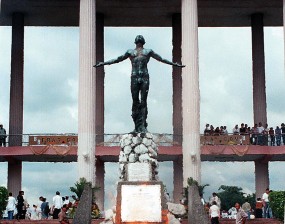BAGUIO CITY—The University of the Philippines can invest in high-stakes projects to earn bigger dividends when it completes a three-year plan to digitally centralize the administration, communication and financing systems of all UP campuses in 2014, UP President Alfredo Pascual said.
He said the P750-million e-UP project was designed to improve productivity and make managing the UP system more efficient once UP Diliman is wired with other autonomous units in Manila, Los Baños, Baguio, Visayas and Mindanao, using a dedicated information and communication technology backbone.
The system provides a single data bank for students and faculty and administrative information. It also provides a unified library system for researches, publications and other activities.
“The e-UP will bind us together and will also enable us to reach out beyond our borders to other state universities and colleges,” Pascual said, adding that UP’s scholarly papers will be made available to a much bigger online audience.
But in a period characterized by a weakened global economy, e-UP should enable the UP system to improve the way it manages its finances, Pascual said at the launch of the digital project at UP Baguio last month.
He said e-UP will allow the facility to unify close to P14 billion in financial assets that are scattered across the UP system. Some campuses secure their idle cash as time deposit accounts, which “yield very low interest earnings of 2 percent when better fund managers could invest their money in accounts that should earn UP as much as 6 percent,” he said.
He said: “In the United States [which is crawling out of a recession], the interest rates are very low—and getting close to zero. Last year, Harvard University earned 15 percent on their endowment funds…. The way they do it is they pooled all their funds [which could be used for investments] from different units … and in the process they are able to take bigger risks with the potential for bigger returns.”
“We have a plan to do that as well. We will put funds which are now dispersed across the UP system and manage these funds as one pool. We will get professional managers to help us manage our funds…. If we make only 1 percent earnings, that is P140 million. That’s a lot,” he said.
The e-UP can track down the cash, coordinate its use and account for the earnings which would be returned to the campuses where the funds originated, he said.
“We can no longer afford to do things [the old] way … which was inefficient and very expensive for UP,” he said.
“It has been very difficult to get information within the UP system … Until now I have not gotten a single accurate data on STFAP (Socialized Tuition and Financial Assistance Program). We need to be able to profile our students. Are we getting more students from richer or poorer families? If we are to make changes in the bracketing of STFAP, what is the impact on our finances?” he said.
He said e-UP may also alter the way UP teaches its students. As the student population outpaces the facility, teachers could provide lectures or group assignments online in the same manner some universities in Singapore now operate, he said.
